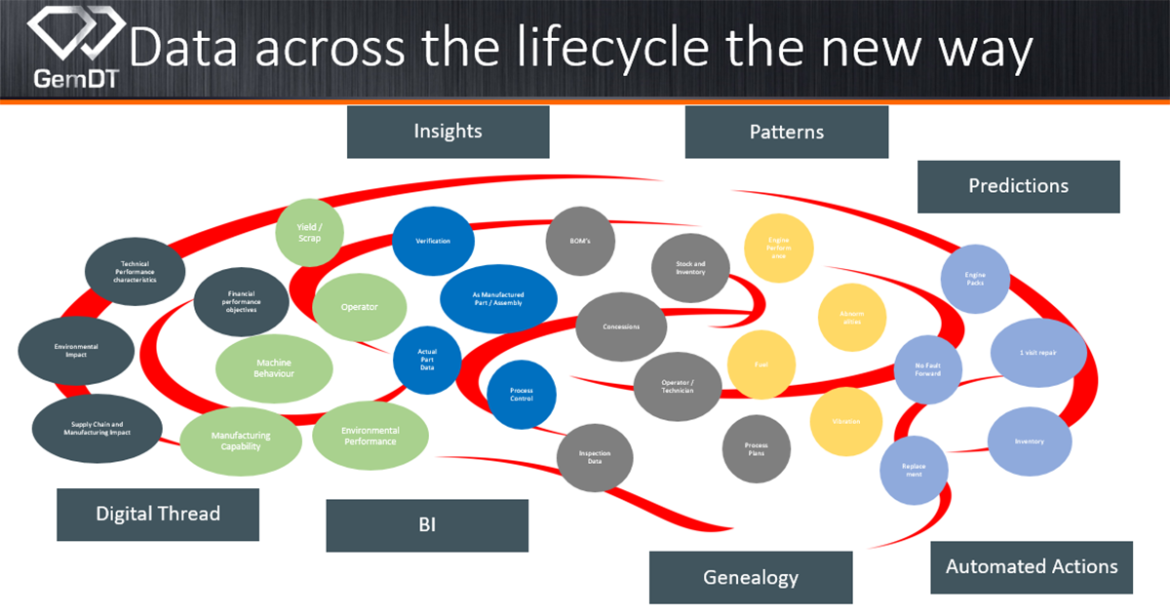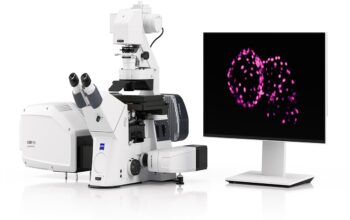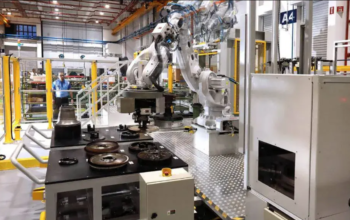As part of the suite of products GemDT are looking to develop and deploy for The Digital Twin, Quality and Inspection is a key component. Utilising data across the manufacturing and support cycle is the key to a business improving quality, reducing errors, improving profitability and customer satisfaction.
Having the full point cloud giving dimensional data, visual data and automated reporting from our GigaScan photogrammetry inspection solution is a key enabler in the TRUE Digital Twin. Seeing what you have manufactured, as well as what you should have manufactured, aligning this model, with the IoT data that has been generated at the start of the process, and through the products life.
To this end, we overview here one of the tools that takes advantage of data, be it IoT, CAD, PLM, ERP, HR, BOM, MES, SCM or SPC the GemDT Augmented Reality Quality & Inspection tool, is using data for the engineer, technician, manager or director, sharing data to improve the product and the service internally with the customer or service provider.
Quality Control and Inspection
Inspection is primarily based on a series of activities carried out either in a traditional method like CMM or Laser Scanning, or manually to assess the quality of component/s and/or assembles to determine if the “As Manufactured” and “As Built” corresponds accurately to the “As Designed” specifications derived from 3D CAD models.
When conducting quality & inspection tasks, technicians will be looking to verify that the manufacturing processes employed to create the part/product have been followed correctly and where appropriate, note any deviations from the “As Designed Model” that will require the correction or amendment of tooling, production processes, 3D models, 2D drawings, or any other contributory material leading up to the manufacture of the component if errors are found.
The key to the successful production of a part or product and ensuring the correct process is followed is “Data”. Data ensures the person, machine or the required process can be followed, humans reading work instructions, machines taking 3D data. Using IoT to ensure the temperature is correct, humidity in the manufacturing area is within the correct parameters and checking the material or process used are the right one for the task.
Having that Data in the correct place with the right person or machine will ensure parts or products can be manufactured and assembled correctly. And when in service ensure they are maintained correctly.
Historically, quality & inspection as a task is carried out using a range of techniques from basic step-by-step visual inspections through to the use of more complex systems such as CMM and Laser scanning.
Quality & inspection technicians will utilise traditional 2D drawings or, if available 3D models to manually compare using process and procedures and measures the component or assembly in the prescribed way. During this process the technician typically will be referring to printed checklists, workflows and procedures to guide them through the sometimes complex and tedious task of verification and validation.
Whilst it is essential in almost all production industries to have some form of inspection prior to assembly it is, at present a predominantly mixture of automation and manual exercises that consumes a large amount of time and can in some cases, take days or weeks (depending on the scale and complexity) for the technician to complete.
Augmented Reality (AR) Design Verification & Inspection Tool (DVIT) from GemDT
Gemini Digital Technologies (GemDT) is a Digital Twin Consultancy organisation looking at product and solutions to enable The Digital Twin. We implement, execute and deliver our services across various industries often facing 2D-3D, Inspection and Data Management challenges within the engineering and manufacturing and support sectors.
Our strong relationships within Aerospace, Defence and the Automotive sectors has enabled us to create maximum value for our clients. Coupled with partnerships with worldwide software and hardware companies, we have the best of breed products, to enable quicker time to market and fast ROI to our client base.
Utilising our expertise in the 3D world, GemDT have developed an AR based quality & inspection tool that can either be used stand-a-lone or to complement existing quality or inspection processes and procedures within our client’s environments.

The DVIT for quality & inspection designed by GemDT can be used in multiple production scenarios to enable consistent inspection activities to be carried out that include, but are not limited to the following examples:
- Verification of components and/or assemblies prior to final build
- Identify potential errors between incompatible parts before assembly
- Verification of components and/or assemblies prior to delivery
- Conformance to, or deviation from the “As Designed”
- Embedded as part of recoding The Digital Twin in Manufacture & MRO
One of the primary reasons, and cost benefits to perform constant fast inspection is that it is less costly to correct an error prior to assembly than it is to disassemble a component or assembly to rectify an error post assembly. For this reason, quality & Inspection are essential processes in any manufacturing environment, but traditional methods are slow and hinder improved manufacturing cycles.
DVIT for Quality & Inspection
GemDT has developed the DVIT for inspection to work across all platforms (Windows, iOS and Android) and can be deployed on any AR capable device to enable virtual 3D overlays of data onto the real word physical components or assemblies within your environment.
The key component to the utilisation of the DVIT is using the GemDT GigaScan inspection solution, capturing a full point cloud of a part, assembly or full product in a fast, accurate and repeatable way.
The ability to have a full point cloud of a part at the point of manufacture, enables for the first time the reutilisation of that parts data across the business. Having the point cloud when using the DVIT tool ensures that if there are issues in manufacture or build, this data can then be shared with Design, Manufacture, Concession Management or the supply chain.
By picking up the issues, using the DVIT workflow on the tablet or wearables, data can be sent fast to resolver groups and they can work in a collaborative way to ensure errors are fixed and a knowledge database can be populated to ensure lessons are learnt and not repeated.
DVIT Application
Utilising the inbuilt camera functionality of the AR device for image capture, the DVIT application will, either through the use of markers and/or 3D tracking capabilities, overlay 3D virtual objects directly onto the physical component and/or assembly.
The DVIT application consists of 4 (four) stages;
- Detection
- Utilising a mobile device to automatically detect a physical component and/or assembly
- Augmented Data Overlay
- Once detected, display an augmented overlay onto the physical assembly via the mobile device application GUI
- Manual/Automated Verification Recording
- The ability to manually/automatically identify and record an error between the physical assembly and the augmented view via the application GUI
- Automated Report Generation
- The creation and sending of automated reports to relevant personnel using the GemDT Engineering Hub
GemDT’s DVIT allows quality & inspection technicians to quickly identify and record any variances between the “As Designed” 3D model and the “As Built” physical component and/or assembly and full product. The DVIT GUI is extremely intuitive in design and guides the technician through the inspection/quality process which ensures conformance to existing processes and procedures are maintained throughout the task. Additionally, the use of an automated DVIT will enable faster training and implementation for new technicians thus reducing costs often associated with bringing in new technicians for the inspection activity.
The ability to record and to automate tasks, whilst reducing training costs, also reduces errors and ensures products are delivered faster, and management of concessions is greatly reduced, improving profitability.
Due to the DVIT’s ease of use and reduced training requirements GemDT’s clients have reported an increase in the technician’s levels of satisfaction, reduced errors, faster time to completion and an overall level of increased confidence in comparison to the more traditional paper based inspection and quality process.

The DVIT navigation is driven by the AR technology it resides on, so can either be touch sensitive for mobile devices or visually activated if the DVIT Technician is using AR Wearable hardware.
The modes of navigation enable the selection, viewing and manipulation of 3D data any associated metadata. To further extend the capabilities of the DVIT, GemDT can incorporate animated work instructions, 3D interactive technical publications, videos and many other forms of data to assist the DVIT use.
This data collated in The Engineering Hub, data like PLM, ERP, HR, BOM or MES are all available if the technician has the required levels of clearance to access the data for the given task.
Detection, Tracking and Accuracy
The DVIT is designed in such a way that it can utilise various methods of detection to ensure maximum tracking and accuracy capabilities making it far superior to other “single detection” based applications.
The most commonly used method of detection and tracking is through the use of “markers” that are placed in strategic positions on the target component and/or assembly and used by the DVIT application to detect, overlay and track the target. Alternatively, or in conjunction with “markers”, the DVIT application uses 3D, Edge based detection and tracking to ensure that the DVIT application can be used in all scenarios from tight, confined spaces where the fixation of markers is not practical, through to automated production lines where it is more efficient to affix “markers” to production rigs, ensuring guaranteed repeatability and accuracy throughout the production lifecycle.
3D Model Creation and Rendering
The key to any successful AR application, and one that is so often overlooked until the last moment is the data. Obtaining it, linking it and displaying it in such a way that its uses compliment, enhance and extend our clients ability to perform their tasks.
DVIT ROI
With our DVIT for application technicians have the capability to scan any required component or assembly and view 3D models, animated graphics, instructional technical publications and much more. Typical ROI potentials from the utilisation of the DVIT include, but are not limited to:
- Reduction is costs associated with the preparation, storage and updating of traditional 2D drawings or 3D models, work instructions, templates, processes and procedures
- Record Red Lining on drawings in manufacture with a video or camera to pass these on to design or concession management
- Real-time results delivered electronically enabling quicker approval and/or resolution of identified errors
- Pre-defined, repeatable process driven tasks ensure deviations from existing standards are eliminated along with user interpretation of tasks
- Technicians are able to complete tasks quicker, to a higher standard and with less training
- 30%-50% reduction in time-on versus tradition paper based fixed systems (figures obtained from “Augmented Reality in the US Navy – A Roadmap)
- Significantly reduced learning curve resulting in ZERO user errors once technicians are trained on the use of the DVIT
As an Oracle Gold Partner, GemDT’s approach to any Augmented Reality solution is driven by data, and the ability to combine a multitude of data sources, managed by a powerful PLM, ERP, HR, BOM, MES or in house designed software products that can provide what is needed, when it’s needed, and in a format that it’s needed.
By deploying the GemDT Engineering Hub in conjunction with the DVIT, no longer does a business have to be data rich and information poor.









